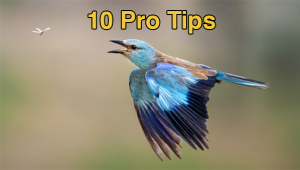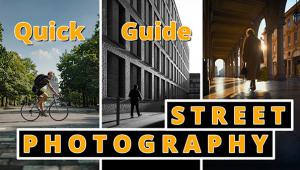Sigma's 80-400mm f/4.5-5.6 EX OS APO
First Independent-Brand Lens With Optical Image Stabilizer Page 2
For the ultimate in image quality at very long focal lengths, I stopped down to f/8 or f/11 for ultrahigh resolution of fine detail plus excellent edge to edge sharpness. This tactic produced another benefit in air show images that included the sky: it eliminated the darkening of the corners that was obvious in images made at wider apertures. Frankly, vignetting is a problem with most zooms but it's not readily noticeable in images with more typical backgrounds such as foliage.
Optical Stabilizer Evaluation
Because blur from camera shake is the primary cause of unsatisfactory pictures,
the OS system is a valuable amenity. And the Sigma technology is certainly successful,
as I discovered while shooting at low ISO (film and digital) to record animal
portraits at a wildlife safari park, the action at a junior soccer game, and
the parked aircraft at a couple of air shows. Without the OS system, I generally
needed to work at around 1/500 sec for razor-sharp images at the longest focal
length. After activating the stabilizer, I was able to make equally sharp images
of static subjects at 1/90 sec. Bracing my elbows on a solid object produced
even more impressive results: many professionally sharp images at 1/30 sec and
occasionally at 1/15 sec at 400mm.
Because I rarely needed to worry about long shutter speeds when using the OS
system, I could shoot with confidence at ISO 50 even when using a polarizing
filter and small apertures for an extensive range of apparent sharpness. On
sunny days when using an aperture of f/16 and a polarizer, the shutter speed
was around 1/45 sec, fast enough for sharp images at many focal lengths. Naturally,
the exposures were substantially longer on dark, overcast days, so I switched
to wider apertures or higher ISO settings in order to maintain a suitable shutter
speed.
 |
|
 |
|
|
Note: My tests
of the effectiveness of the OS system were conducted with a 35mm camera and
a digital SLR with full-frame sensor at 400mm. On an SLR with a smaller sensor,
the effective focal length at the long end is 600mm, 640mm, or 680mm, depending
on the camera's exact sensor size. Although this effect is actually produced
by field of view crop, not by greater magnification, it's worth using
slightly higher shutter speeds with such cameras. That's because the smaller
image will require greater magnification for making prints of any desired size,
so any blur (from camera shake) will be more obvious, especially in oversized
prints.
Most of the recent Canon IS and Nikon VR lenses can be used with the stabilizer
when the camera/lens is mounted on a tripod. However, Sigma recommends disengaging
their OS system when using a tripod unless the camera is being moved for panning
or unless there is a great deal of camera shake, as on a very windy day when
using a flimsy tripod. I don't see this as a disadvantage because there's
no need for a stabilizer when the lens is rock steady. Working without OS also
helps to conserve battery power, a significant benefit because power drain is
increased by about 50 percent with full-time stabilizer use.
(SIDEBAR) Sigma's
OS system consists of two types of sensors inside the lens to detect the angle
and speed of vertical and horizontal camera movement. When shake is detected,
a signal is sent to a special motor with instructions to shift a group of lens
elements in the appropriate direction to counteract the effect of lens shake.
This causes incoming light rays to be refracted so the image is returned to
the center of the frame; consequently, the projected image is stable, allowing
for sharper pictures.
Note: Owners of Nikon-mount cameras should be aware that OS
will not operate with all SLR models. (The same applies to Nikon's own
VR system.) At the time of this writing, the Sigma OS system is compatible with
the following: F100, N80, N65, N75, D2H, D1 series, D100, D70, and the Fujifilm
FinePix S2 Pro. (It should also work with the FinePix S3 Pro.) When used with
the Nikon F5, autofocus will also cease to function.
Two OS modes are available. In Mode 1, the system detects and compensates for
both vertical and horizontal movement of the camera, ideal for most types of
photography. Switch to Mode 2 if you plan to pan with an action subject moving
across your line of vision. Now, the system will compensate only for vertical
(up/down) camera movement, and not for the intentional horizontal movement used
when following a moving subject. This feature is useful especially for sports
and racing photography, where you want to use a long shutter speed. For the
best results, pan the camera/lens at exactly the same speed as the subject's
motion. In the resulting images, the subject should be fairly sharply rendered,
while the background will be smoothly streaked--without blurring from up/down
camera shake--for a convincing effect of motion in a still image.
Final Assessment
It's unfortunate that this lens is not available in Minolta and Pentax
mounts, because it would finally give the owners of such systems access to a
lens with an image stabilizer. Canon, Nikon, and Sigma SLR owners will find
a great deal to like about this lens in terms of optics, build quality, and
features. While an ultrasonic focus motor would make the Sigma 80-400mm f/4.5-5.6
EX OS APO even more effective for sports and bird photography, it should certainly
satisfy the vast majority of photo enthusiasts. Some photographers prefer to
use tripods for all their work, but others will consider the OS to be a blessing.
In any event, the addition of the OS system makes this Sigma tele-zoom highly
versatile and it will surely help many photographers to increase their success
ratio of technically excellent images.
For more information, visit Sigma's website at: www.sigma-photo.com.
Technical Specifications
Minimum Aperture: f/22-f/32
Optical Formula: 20 elements in 14 groups
Minimum Focus Distance: 71"
Maximum Reproduction Ratio: 1:5
Filter Size: 77mm
Controls: Autofocus/Manual Focus, OS, and Zoom Lock switches
Tripod Mount: Detachable (included)
Vibration Reduction: Two modes; for static subjects and for
panning
Accessories: Case and hood (included); compatible with Sigma
EX APO tele-converters
Dimensions And Weight: 3.7x7.5"; 61.7 oz
Street Price: $1199
A long-time contributor to "Shutterbug" and "eDigitalPhoto," stock photographer Peter K. Burian is the author of a new book, "Mastering Digital Photography and Imaging" (Sybex). Covering the technology, equipment, and techniques, this book provides 270 pages of practical advice.
- Log in or register to post comments

































